
Cucumis anguria, commonly known as maroon cucumber, West Indian gherkin, maxixe, burr gherkin,cackrey, and West Indian gourd, is a vine that is indigenous to Africa, but has become naturalized in the New World, and is cultivated in many places. It is similar and related to the common cucumber (C. sativus) and its cultivars are known as gherkins.

Olea capensis, the black ironwood, is an African tree species in the olive family Oleaceae. It is widespread in sub-Saharan Africa: from the east in Somalia, Ethiopia and Sudan, south to the tip of South Africa, and west to Cameroon, Sierra Leone and the islands of the Gulf of Guinea, as well as Madagascar and the Comoros. It occurs in bush, littoral scrub and evergreen forest.

Hydrocotyle, sometimes called water pennywort, Indian pennywort, dollar weed, marsh penny, thick-leaved pennywort and even white rot is a genus of prostrate, perennial aquatic or semi-aquatic plants formerly classified in the family Apiaceae, now in the family Araliaceae.

Voacanga africana is a small tree native to tropical Africa belonging to the family Apocynaceae that grows to 6 m (20 ft) in height and bears leaves that are up to 30 cm (12 in) in length. The yellow or white flowers are succeeded by paired, follicular, dehiscent fruit with a mottled green exocarp and a pulpy, yellow mesocarp surrounding the seeds. The plant contains alkaloids acting as CNS depressants and hypotensives
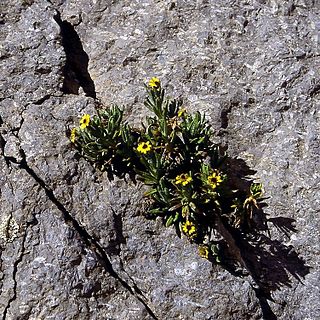
Atop of Mount Kenya Senecio keniophytum is one of the endemic groundsel (Senecio) found at high altitudes in Kenya, such as the Afro-alpine zone of Mount Kenya, but not one of the giant Dendrosenecio that also live there.

Ipomoea indica is a species of flowering plant in the family Convolvulaceae, known by several common names, including blue morning glory, oceanblue morning glory, koali awa, and blue dawn flower. It bears heart-shaped or 3-lobed leaves and purple or blue funnel-shaped flowers 6–8 cm (2–3 in) in diameter, from spring to autumn. The flowers produced by the plant are hermaphroditic. This plant has gained the Royal Horticultural Society's Award of Garden Merit.

Ipomoea nil is a species of Ipomoea morning glory known by several common names, including picotee morning glory, ivy morning glory, and Japanese morning glory. It is native to the tropical Americas, and has been introduced widely across the world.
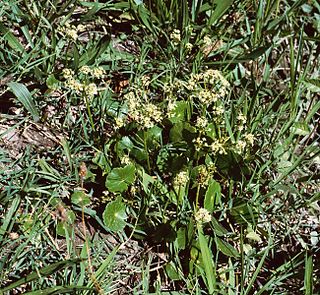
Hydrocotyle bonariensis, the largeleaf pennywort, once a member of the family Apiaceae, now in the family Araliaceae and of the genus Hydrocotyle, is a hairless and creeping perennial.

Forsskaolea tenacissima is a member of the non-stinging nettles genus Forsskaolea and is in the same family as the stinging kind, Urticaceae. Described as "looking like a tough character that does not want or need a caress", F. tenacissima makes its home where not many plant species survive, in stony soils, road edges, in the gravel wadi and "in the rock crevices and water-receiving depressions" above the stone pavements of the Hamadas.

Yushania alpina, the African alpine bamboo, is a perennial bamboo of the family Poaceae and the genus Yushania It can be found growing in dense but not large stands on the mountains and volcanoes surrounding the East African Rift between the altitudes of 2,500 meters and 3,300 meters.

Dendrosenecio adnivalis is one of the giant groundsels of the mountains of Eastern Africa. D. adnivalis grows on the Rwenzori Mountains and on the Virunga Mountains in Uganda and the Democratic Republic of Congo.
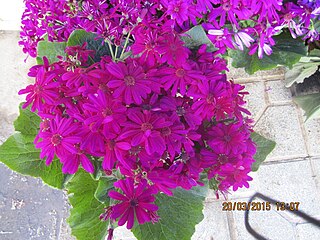
Cineraria deltoidea is a perennial flowering plant of the family Asteraceae and the genus Cineraria who is also the closest known relative of the giant Dendrosenecio of East Africa.

A pitaya or pitahaya is the fruit of several different cactus species indigenous to the Americas. Pitaya usually refers to fruit of the genus Stenocereus, while pitahaya or dragon fruit refers to fruit of the genus Selenicereus, both in the family Cactaceae. Dragon fruit is cultivated in Mexico, Southeast Asia, India, the United States, the Caribbean, Australia, Mesoamerica and throughout tropical and subtropical world regions.

Ampelocissus is a genus of Vitaceae having 90 or more species found variously in tropical Africa, Asia, Central America, and Oceania. The type species, A. latifolia, was originally treated under its basionym, Vitis latifolia, and was collected from the Indian subcontinent.

Schizachyrium is a widespread genus of plants in the grass family. The name is derived from the Ancient Greek words σχίζειν, meaning "to split," and ἄχυρον, meaning "chaff." It refers to either the glume or the toothed lemmas.
Ampelocissus abyssinica is a large climbing vine native to southeast Ethiopia, where it is known in the Afaan Oromo language by the name teru, and is used as a herbal treatment for the medical condition known as black leg. Its first botanical description was in 1847 as Vitis abyssinica, that name being the basionym for its treatment here under the genus Ampelocissus.
Ampelocissus concinna is a species of flowering plant in the Vitaceae family. It is a climbing vine or liana in the grape family native to Angola.
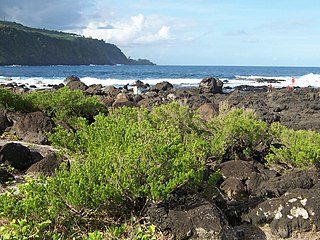
Pemphis is a genus of maritime plants in family Lythraceae. It was recently thought have only one species but is now believed to have at least two.

Aneilema aequinoctiale is a flowering shrub native to much of sub-Saharan Africa. It is sometimes referred to by its English common name, clinging aneilema, and in Yoruba, a language of West Africa, it may be referred to as ẹfĩajija.
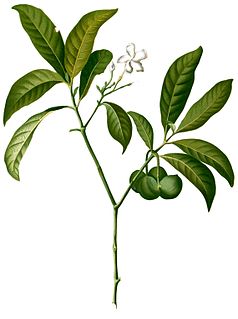
Voacanga is a genus of plants in the family Apocynaceae found in Africa, Southeast Asia, New Guinea, and Australia. As of August 2013 the World Checklist of Selected Plant Families recognises 13 species:
- Voacanga africanaStapf ex Scott-Elliot - tropical W + C + E + S Africa
- Voacanga bracteataStapf - tropical W + C Africa
- Voacanga caudifloraStapf - tropical W Africa
- Voacanga chalotianaPierre ex Stapf - tropical C Africa
- Voacanga foetida(Blume) Rolfe -Java, Borneo, Sumatra, Philippines
- Voacanga globosa(Blanco) Merr. - Philippines
- Voacanga gracilipes(Miq.) Markgr. - Maluku
- Voacanga grandifolia(Miq.) Rolfe - Indonesia, Philippines, New Guinea, Queensland
- Voacanga havilandiiRidl. - Sarawak
- Voacanga megacarpaMerr. - Philippines
- Voacanga pachycerasLeeuwenb. - Zaïre
- Voacanga psilocalyxPierre ex Stapf - Nigeria, Cameroon, Gabon, Republic of Congo
- Voacanga thouarsiiRoem. & Schult. Madagascar; widespread from Cape Province to Sudan + Senegal
- Voacanga dichotoma = Tabernaemontana pachysiphon
- Voacanga plumeriifolia = Tabernaemontana macrocarpa

















